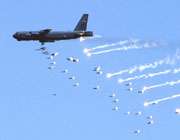The Day in History:
Strategic Arms Reduction Treaty Signed by the US and USSR (1991)
START (for Strategic Arms Reduction Treaty) is a treaty between the United States of America and the Union of Soviet Socialist Republics (USSR) on the Reduction and Limitation of Strategic Offensive Arms.
The treaty was signed by the United States and the USSR, that barred its signatories from deploying more than 6,000 nuclear warheads atop a total of 1,600 ICBMs, submarine-launched ballistic missiles, and bombers. START negotiated the largest and most complex arms control treaty in history, and its final implementation in late 2001 resulted in the removal of about 80% of all strategic nuclear weapons then in existence. Proposed by United States' President Ronald Reagan, it was renamed START I after negotiations began on the second START treaty, which became START II.
Proposal
The first START proposal was presented by United States' President Ronald Reagan in Geneva on 29 June 1982. Reagan proposed a dramatic reduction in strategic forces in two phases, which he referred to as SALT III at the time. The first phase would reduce overall warhead counts on any missile type to 5,000, with an additional limit of 2,500 on ICBMs. Additionally, a total of 850 ICBMs would be allowed, with a limit of 110 "heavy throw" missiles like the SS-18, with additional limits on the total "throw weight" of the missiles as well. The second phase introduced similar limits on heavy bombers and their warheads, and other strategic systems as well.
At the time the US had a commanding lead in strategic bombers. The US B-52 force, while aged, was a credible strategic threat but was only equipped with AGM-86 cruise missiles, beginning in 1982, because of Soviet air defense improvements in early 1980s. The US also had begun to introduce new B-1B quasi-stealth bomber and was secretly developing the ATB project. The USSR's force was of little threat to the US, on the other hand, as it was tasked almost entirely with attacking US convoys in the Atlantic and land targets on the Eurasian landmass. Although the USSR had 1,200 medium and heavy bombers, only 150 of them (Tupolev Tu-95's and Myasishchev M-4s) could reach North America (the latter only with in-flight refueling). They also faced difficult problems in penetrating admittedly smaller and poorly defended US airspace. Possessing too few bombers available when compared to US bomber numbers was evened out by the US forces having to penetrate the much larger and heavier defended Soviet airspace. This changed when new Tu-95MS and Tu-160 bombers appeared in 1984 equipped with first Soviet AS-15 cruise missiles. By limiting the phase-in as it was proposed, the US would be left with a strategic advantage, for a time.

As Time Magazine put it at the time, "Under Reagan's ceilings, the U.S. would have to make considerably less of an adjustment in its strategic forces than would the Soviet Union. That feature of the proposal will almost certainly prompt the Soviets to charge that it is unfair and one-sided. No doubt some American arms-control advocates will agree, accusing the Administration of making the Kremlin an offer it cannot possibly accept—a deceptively equal-looking, deliberately nonnegotiable proposal that is part of what some suspect is the hardliners' secret agenda of sabotaging disarmament so that the U.S. can get on with the business of rearmament." Time Magazine did point out that, "The Soviets' monstrous ICBMs have given them a nearly 3-to-1 advantage over the U.S. in "throw weight"—the cumulative power to "throw" megatons of death and destruction at the other nation."
Negotiations
Continued negotiation of the START process was delayed several times because US agreement terms were considered non-negotiable by pre-Gorbachev Soviet rulers. President Reagan's introduction of the Strategic Defense Initiative program in 1983, regardless of its possible disinformation and propaganda goals, was viewed as a threat by the Soviet Union, and the Soviets withdrew from setting a timetable for further negotiations. Due to these facts, a dramatic nuclear arms race proceeded during the 1980s, and essentially ended in 1991 by nuclear parity preservation at a level of more than ten thousand strategic warheads on both sides.
Ratification
It was signed on July 31, 1991, five months before the collapse of the Soviet Union. Entry-into-force was delayed due to the collapse of the USSR and awaiting an Annex that enforced the terms of the treaty upon the newly independent states of Russia, Belarus, Kazakhstan, and Ukraine. The latter three agreed to transport their nuclear arms to Russia for disposal.
It remains in effect between the U.S. and Russia, Belarus, Kazakhstan, and Ukraine These latter three have disarmed since becoming independent nations in the wake of the break up of the Soviet Union.
Today, the United States has 5,866 and Russia has 4,162 deployed warheads.
B-52 Stratofortresses chopped into five pieces at AMARC
Implementation365 B-52Gs were flown to the Aerospace Maintenance and Regeneration Center at Davis-Monthan Air Force Base in Arizona. The bombers were stripped of all usable parts, then chopped into five pieces by a 13,000-pound steel blade dropped from a crane. The guillotine sliced four times on each plane, severing the wings and leaving the fuselage in three pieces. The ruined B-52s remained in place for three months so that Russian satellites could confirm that the bombers had been destroyed, after which they were sold for scrap.
Source: encyclopedia.thefreedictionary.com
Other Links:
The Day in History: Nixon and Khrushchev Engage in Kitchen Debate (1959)
The Cerro Maravilla Incident (1978)